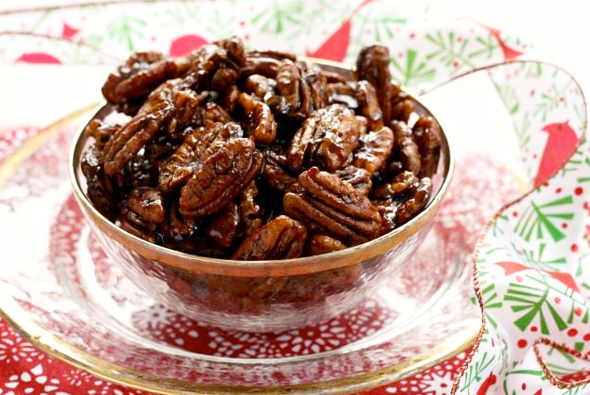Mama’s Punjabi Recipes: Gur Galef Pecans (Molasses Coated Pecans)
Saved under Community, Current Stories
Tags: Baytown, Clear Lake, Cypress, Desi news, Greater Houston, Houston, Houston Desi news, India, Indian American community, Indian News, Indians in America, Indo-American News, Katy, NRI, pearland, south asia, South India, Sugar Land, Texas, USA
In the Indian northwest region, from Afghanistan to Uttar Pradesh, nuts and dried fruits are extremely popular, and in particular badam (almonds) which are used in religious rituals and ceremonies too. If you go further beyond the Subcontinent’s borders into Iran, Turkey and Central Asia, nuts of all types – badam (almonds), kharot (walnuts), kaju (cashews), moongfli (peanuts), pistachios (piste), almonds, apricot (khurmani) seeds, hazelnuts, cantaloupe (kharbuja) and pumpkin (petha) seeds, pine nuts (chilgoze) – are very popular in snacks or desserts.
What aren’t popular – because they aren’t readily available in India – are pecans (mostly grown in the US in Texas and Georgia), macadamia nuts (mostly grown in Hawaii), chestnuts (mostly from Europe or China), hazelnuts and pili nuts (found only in the Philippines). The Chinese have recently acquired a taste for pecans which has raised their prices, but Indians still think of them like walnuts, “only sweeter, softer and easier to break” as my niece Poonam Talwar in New Delhi said when she tasted the bag I took home last year and couldn’t stop eating them.
During the winter months in North India, even though they are quite expensive, nuts and mewah (dried fruits) are very often used in all types of mithai (sweetmeats) like burfi (reduced milk squares). Gajack (peanut brittle in gur (sugar cane jaggery)) is very popular and is sold in the cities by street vendors.
Pecans are a rich source of dietary fiber, protein, iron and B vitamins as well as manganese, magnesium and phosphorus, with mainly monounsaturated fatty acids. They are rich in age defying antioxidants, and among other benefits are cardiovascular health, promote digestion, weight loss, inflammation reduction, skin benefits, prevention of hair loss and stimulating hair growth.
In the Southern US, pecans are often used in many recipes, like pies, cakes and cookies or simply served as a roasted snack. During the winter Holiday Season, this timely recipe will come in handy because it is fairly easy to make. Unlike walnuts, pecans do not irritate the palate and the gur coating makes them irresistible.
Ingredients:
• 500gm pecan giri (shelled pecans)
• 500gm gur (rock molasses)
• ¼ tsp saunf (fennel seed)
• ¼ cup pani (water)
Directions:
1. Chop the pecans into halves so that they are easier to coat and eat.
2. Break the gur into smaller pieces. Place a frying pan over high heat, pour in the water and when it is nice and hot, throw in the gur pieces and let them melt.
3. Add the fennel seed and stir well for 5 minutes. Test the melted gur to see if it runs a sticky ribbon when stirred and touched.
4. Turn the heat off and throw in the pecan pieces and stir well and quickly to coat them and make sure the pecans aren’t clumped together.
5. Place on a plate to let the pecans cool off; when cool place in an air-tight jar so that they don’t become humid.
MAMA’S TIP OF THE WEEK: CLEAN LEATHER FURNITURE WITH WATER & WHITE VINEGARMany people have leather furniture in their homes, like couches and sofas or even dining chairs, and over time these tend to get dirty with use, especially if they are light colored. Or they have had a lot of home remodeling work done, and their leather furniture is dirty from the dust that has settled on. Some vinyl topped items also show stains from constant use.
The best way to clean these items is with a mixture of equal parts of water and white vinegar. Take a soft, clean white cloth and dip it into the mixture, squeeze out most till it is just damp, then gently wipe the leather. Test it out in a small area first and when satisfied, start from the top down. Discard the cloth after it is completely dirty and continue with another clean one. You’ll be amazed how quickly and easily it cleans the leather!

Shakuntla Malhotra is a skilled cook of Punjabi dishes made in the old-fashioned style that she learnt as a young woman in her ancestral home in Lyallpur, India (since renamed Faisalabad) before it became part of Pakistan after the Partition in 1947. People have often admired her cooking for its simplicity and taste that comes with each mouthful. Even in her late-eighties, she continues to cook daily and agreed to share her delectable Punjabi vegetarian recipes for future generations.

